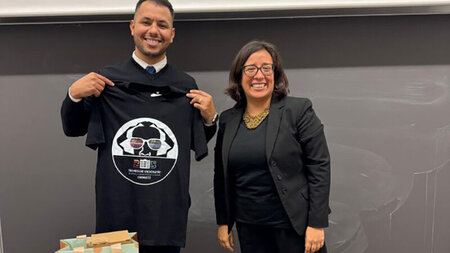Intelligent Fiber-reinforced Ceramics with Integrated Carbon-based Sensors
A research team at Chemnitz University of Technology developed innovative ceramic composites with integrated carbon nanotubes (CNTs) for real-time structural health monitoring
-

Dhivakar Rajendran, Amoog Lakshmanan and Olfa Kanoun investigate fiber-reinforced ceramic samples with integrated carbon-based sensors. Photo: She Ge
An interdisciplinary team of researchers at Chemnitz University of Technology has succeeded in developing a groundbreaking ceramic composite material that can monitor its own structural integrity. The research work, led by Prof. Dr. Olfa Kanoun from the Chair of Measurement and Sensor Technology in collaboration with Prof. Dr. Daisy Nestler from the TKV research area of the Chair of Lightweight Structures and Polymer Processing, shows how carbon nanotubes can be integrated into oxide ceramic composite materials (OCMC) to create reliable self-sensing materials.
Revolutionary approach overcomes conventional monitoring limitations
Conventional monitoring of the structural condition of ceramic composites in extreme environments faces major challenges. Conventional methods, such as acoustic emission monitoring, thermal stress analysis and surface-mounted flexible sensors, often fail under flexible temperature conditions, including thermal shock, or suffer from low sensitivity due to insufficient load transfer between the structure and the sensing elements. “The key innovation is to embed multi-walled carbon nanotubes directly into the ceramic matrix instead of mounting the sensors on the surface,” explains Kanoun. “This creates a truly integrated sensor system where the ceramic structure itself becomes the sensor, eliminating the problems of sensor detachment and poor load transfer that occur with surface-mounted solutions.”
Advanced manufacturing process ensures homogeneous integration
The research team used a sophisticated solution mixing approach in combination with ceramic injection molding to achieve a uniform distribution of the carbon nanotubes in the ceramic matrix. The multi-walled carbon nanotubes (MWCNTs), which make up only 0.5 percent by weight of the total composition, form an electrically conductive network within the oxide ceramic composite. The realized manufacturing process offers key advantages, including uniform distribution of the carbon nanotubes for improved material performance, enhanced mechanical properties, precise and cost-effective shaping through the mass production of the injection molding process, and preservation of the nanotubes' integrity through controlled thermal treatment in an inert atmosphere. "Our microstructural analysis using scanning electron microscopy confirms that the carbon nanotubes remain in close contact with the ceramic matrix and form a network even after sintering at 1200°C," says Nestler. "This is crucial for maintaining the electrical conductivity that enables the strain measurement function. At the same time, the reinforcement by Al2O3 fibers in an Al2O3 matrix realizes better fracture toughness and thermal shock resistance compared to a monolithic ceramic."
Exceptional sensor properties with high reproducibility
The MWCNT/OCMC sensors developed have remarkable performance characteristics. In four-point bending tests, strain factors of 7.99 in the low strain range (0-160 μ-strain) and 2.12 in the higher strain range (160-380 μ-strain) were determined. Importantly, the sensors have excellent reproducibility, with deviations of less than 2.7% between independently manufactured specimens. "The resistance changes exponentially with the applied strain due to the tunneling effect between the carbon nanotubes," explains M.Sc. Dhivakar Rajendran, the lead author of the paper. "When the ceramic is stretched, the nanotubes move closer together, creating new conductive paths and drastically changing the electrical resistance of the material. This provides a highly sensitive method for detecting even the smallest structural deformations, which is essential for deducing the damage behavior," adds Sarra Missaoui, the first co-author.
European collaboration advances ceramic matrix composites and robust industrial applications
This research was carried out as part of an M-ERA.net project under the European Union's Horizon 2020 research framework program "Ceramics with sensing capabilities for high temperature applications (Centaur)". The work addresses critical requirements in the aerospace, automotive and industrial sectors, where ceramic components must perform reliably in extreme environments up to 1650°C, which can only be realized with composite materials. Spectroscopic analysis using FTIR and Raman spectroscopy confirmed that the carbon nanotubes maintain their structural integrity and properties throughout the manufacturing process, with no signs of oxidation or degradation. This is critical for maintaining long-term sensor performance under harsh operating conditions.
Future applications and impact on industry
The technology opens up new possibilities for monitoring the condition of structures in real time in areas where conventional sensors cannot cope. Potential applications include turbine blades, thermal barrier coatings and other structural components in aerospace and energy systems. "This truly integrated approach represents a paradigm shift in structural health monitoring," says Kanoun. "Instead of attaching ready-made sensors to a structure, we are making the structure itself intelligent. This could revolutionize the way we monitor and maintain critical components in extreme environments."
The research team is now working on optimizing the concentration of carbon nanotubes and exploring applications in temperature sensing based on this breakthrough in strain sensing.
Publication: Dhivakar Rajendran, Sarra Missaoui, Jonas Stiller, Rajarajan Ramalingame, Uwe Zschenderlein, Bernhard Wunderle, Daisy Nestler, Olfa Kanoun. "Truly integrated carbon nanotubes (CNT) in oxide ceramics for micro-strain sensing applications." Ceramics International, June 2025. DOI: https://doi.org/10.1016/j.ceramint.2025.05.219
Further Information: Prof. Dr. Olfa Kanoun, phone +49 (0)371 531-36931, email olfa.kanoun@etit.tu-chemnitz.de
Mario Steinebach
01.07.2025




